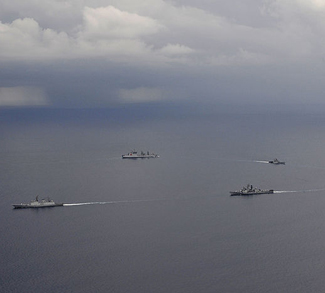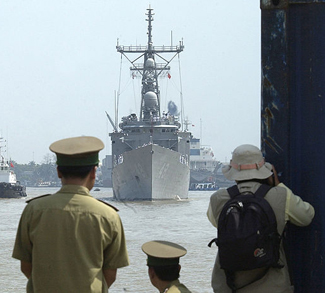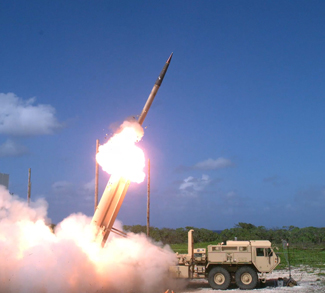President Obama’s upcoming visit to Vietnam could amount to far more than just a symbolic political photo opportunity. It comes amid suggestions that the U.S. may be about to lift an arms embargo which has remained in place for four decades. If this were to happen, it would signal a historic shift in perspective and represent the most significant stride forward in diplomatic relations to date between these two former adversaries, more than 40 years after the end of the Vietnam War.
However it is not just time which has healed old wounds: this blossoming friendship has been rapidly propelled forward as a result of the unresolved territorial disputes in the South China Sea. China’s increasingly assertive actions, such as land-reclamation and drilling for oil in disputed waters, have heightened tensions with neighbouring Vietnam. These perceived attempts by China to expand its influence into the wider region have led to it being viewed as a common security threat by both Vietnam and the United States, resulting in a remarkable rapprochement between two historical enemies.
Whilst diplomatic relations were formally restored in 1995, it has taken a further 20 years for the U.S. and Vietnam to put their past differences aside and forge a closer alliance with the aim of balancing China’s rising power in the Asia-Pacific. The South China Sea is vitally important to both countries in strategic and economic terms; therefore China’s extended control is viewed as threat to national interests. From the Vietnamese perspective, maintaining control over its waters is crucial for maritime defence, whilst ensuring access to potential energy reserves is essential to meeting the future needs of its growing population and booming economy. From the U.S. perspective, there are concerns that China’s dominance could lessen US influence in the region and pose a threat to freedom of navigation in an area that is a hub for international trade. The South China Sea’s network of shipping lanes links the Indian and Pacific Oceans, forming a key lifeline for the regional economy and the global trade in natural resources. More than 41,000 ships and US$5.3 trillion in trade pass through each year, whilst the Sea is also estimated to contain up to 213 billion barrels of oil, making it a potentially vital source of energy for the burgeoning populations of South-East Asia.
China claims over 80% of the South China Sea as its territorial waters, and has pushed forward historical arguments to assert sovereignty over the Paracels and Spratly Islands. Several other countries adjacent to the Sea – Vietnam, Malaysia, Taiwan, Brunei, Indonesia and the Philippines – have strongly contested these claims, resulting in a catalogue of maritime clashes. However, due to its geographical proximity and long history of animosity with its giant northern neighbour, it is Vietnam which has emerged as China’s primary maritime rival.
Relations began their transformation following the visit of former Secretary of State Hillary Clinton to Hanoi in July 2012
Despite widespread regional opposition, China has forged ahead with its island-building and land reclamation projects. Some have viewed this as an aggressive attempt by China to expand its authority, militarize the region, and take control of the sea’s resources. These recent activities have followed years of escalating tensions and serious incidents – the most dramatic of which occurred in May 2014 after China moved an oil rig in to waters claimed by Vietnam as its ‘Exclusive Economic Zone’ (EEZ). The dispute quickly evolved into a full-scale diplomatic incident: Vietnam sent 30 patrol boats to disrupt the operation, whilst rare anti-China street protests erupted in Hanoi and Ho Chi Minh City. Additionally, there have been numerous reported incidents of Vietnamese fishing boats being harassed by the PLA Navy, along with accusations of China using its economic power to dissuade foreign oil companies, such as BP and ExxonMobil, from signing exploration contracts with Vietnam in disputed waters.
In light of its assertive territorial claims and displays of dominance in the South China Sea, China has increasingly been presented as a threat not only to Vietnam’s security and economic prosperity, but also to US military hegemony and influence in the Asia-Pacific. Therefore whilst maintaining a relationship of friendly co-operation with the Chinese government across many issue areas, it is becoming increasingly clear that Hanoi and Washington now both view China as a common threat in the South China Sea, resulting in a strong convergence of interests in the security field. The shared desire to balance China’s power in the region has led to the emergence of a once-unthinkable alliance between these two former enemies.
However, this rapprochement would not have been possible at all were it not for a profound shift in US foreign policy after the 2008 election of President Obama. His eight years in power have been characterized by an open-minded, outward-looking and future-oriented approach, creating an environment whereby the US has actively reached-out to establish improved ties with former rivals. This new outlook has paved the way for the normalization of ties with Cuba, along with vastly improved diplomatic relations with Iran – which resulted in last year’s nuclear deal followed by the lifting of long-standing economic sanctions. However the most remarkable turnaround in US foreign policy may yet be the renewed engagement with Vietnam.
Relations began their transformation following the visit of former Secretary of State Hillary Clinton to Hanoi in July 2012; whilst in October 2014, the US eased some of the restrictions laid out in the decades-old arms embargo. If these initial breakthroughs were considered as largely symbolic, more significant progress took place the following year. In July 2015, the general secretary of the Vietnamese Communist Party (VCP), Nguyen Phu Trong, made a landmark visit to Washington and signed an ‘Extensive Comprehensive Partnership’ between the two countries. The alliance may yet be strengthened further, with recent indications suggesting that the U.S. may decide to fully lift the arms embargo later this year. The likely aim would be to strengthen Vietnam’s maritime security capacity in order to balance China’s rapidly expanding naval capabilities.
An alliance which was previously considered impossible now seems to have become political reality, as the signing of the comprehensive partnership signifies a level of mutual trust which has not existed until recently, and which will surely be further enhanced by Obama’s visit. The United States appears to have calculated that the strategic gains of a stronger relationship with Vietnam will outweigh the risks of antagonizing China. The rhetoric of both nations’ leaders, whilst rarely mentioning China explicitly, makes it clear that maritime security is at the heart of their vastly improved relations. A joint statement released during Trong’s 2015 visit to Washington asserts that both countries are “concerned about recent developments in the South China Sea which have increased tensions, eroded trust and threatened to undermine peace, security, and stability” in the region, whilst rejecting “coercion, intimidation and the use of force” to settle disputes. This rhetoric has been backed up by strategic commitments in Washington: the US military has announced its intention to ‘pivot’ towards the Asia-Pacific, pledging to deploy 60% of its warships in the region by 2020. In the maritime arena, Vietnam is seen as a crucial long-term ally in US efforts to counter-balance China.
China shows little sign of backing down from its extensive territorial claims or from its expanding military activities in the South China Sea, leaving the region set to remain a site of intense geopolitical competition in the coming years. As a result, Vietnam’s rapprochement with the U.S. is likely to gain further momentum, and the full lifting of the longstanding arms embargo looks an increasingly likely prospect. Moreover, President Obama’s upcoming visit reaffirms Washington’s commitment to an alliance which could be crucial in balancing China’s power, and important in ensuring long-term stability in the increasingly tense geopolitical arena of the Asia-Pacific.
The opinions, beliefs, and viewpoints expressed by the authors are theirs alone and don’t reflect any official position of Geopoliticalmonitor.com.

![By U.S. Navy photo by Photographer’s Mate 2nd Timothy Smith [Public domain], via Wikimedia Commons By U.S. Navy photo by Photographer’s Mate 2nd Timothy Smith [Public domain], via Wikimedia Commons](https://www.geopoliticalmonitor.com/wp-content/uploads/2016/05/US_Navy_040728-N-8796S-093_Vietnamese_military_officials_watch_as_USS_Curtis_Wilbur_DDG_54_prepares_to_moor_in_the_Vietnamese_port_of_Da_Nang.jpg)


